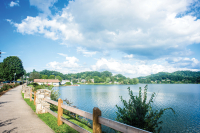Program marries old skills with new needs
Scotty Bowman always knew he wanted to work outdoors, but he couldn’t figure out how to live his dream and also make a livable salary — so he instead paved a career in restaurants, including stints as a chef. At least, this is what Bowman did until hitting his 40s, that momentous time when folks often realize that it’s either now or never to indulge their passions.
Bowman, in taking the risk to build a new career focused on the outdoors, has become part of a unique movement that might just help the Southeast get more Wilderness Areas to enjoy. Bowman has been busy this summer building and fixing trails in remote backcountry settings with Southern Appalachian Wilderness Stewards, a new program of The Wilderness Society that works directly with the forest service to provide support for Wilderness Areas and Wilderness Study Areas.
In Wilderness Areas, you can’t use chainsaws or power tools for trail work, which makes building trails in the backcountry miles from the closest road tough work. The SAWS group is deploying volunteers into Wilderness Areas who are willing to do the heavylifting of trail work using only hand tools, such as crosscut saws, in those remote territories where firing up power tools would violate wilderness regulations.
The labor from SAWS crews not only blazes new trails and keeps existing ones maintained, they could also be key in the effort to get more areas in the national forests designated as wilderness.
Designating new wilderness areas can be controversial given the stricter rules that apply, limiting everything from motorized recreation to hunting to logging to road building.
But even hiking clubs can be against new wilderness designation if it means their volunteer efforts to maintain trails in those areas will become more difficult, explained Brent Martin, Southern Appalachian program director for the Wilderness Society’s, based out of the regional field office in Sylva.
Related Items
Hiking clubs are the front line when it comes to trail maintenance. But, Martin pointed out, they are generally made up of older, retired folks, with small core groups who also work on trail maintenance. And with limited time and energy, these good Samaritans often understandably balk at the wilderness rule of not being allowed mechanized tools such as chainsaws.
Enter younger, eager men and women such as Bowman, who are simply enchanted with being able to use crosscut saws and other primitive tools. A volunteer stint with SAWS has led to a summer job for Bowman as head of a SAWS volunteer trail crew. He hopes to repeat the experience next summer.
The trail crews are trained in using the necessary primitive tools, and learn trail building and trail maintenance techniques.
Bowman is in college, and anticipates perhaps mingling the contacts made through SAWS into a more permanent outside-oriented job, such as with the U.S. Forest Service.
“I always wanted to be outside, to be a part of doing something for the trails and for the public,” the 42-year-old said. “And I’ve picked up some really cool skills doing this.”
And the wilderness areas are picking up a lot of extra maintenance help these days, said Bill Hodge, director of SAWS.
“The idea is not to replace the hiking clubs, it’s to supplement their work,” Hodge said.
In the Southern Appalachian region encompassing North Carolina, Georgia and South Carolina, there are 22 federally designated Wilderness Areas and another 14 Wilderness Study Areas, which fall under the same set of no-mechanized-tools restrictions. Wilderness Study Areas requires congressional approval to move into actual permanently protected Wilderness Areas.
Crews, such as the one led by Bowman, go into the backcountry for five-day stretches at a time to work on the trails. There have also been shorter, weekend-long programs. SAWS is also active through its Wilderness Rangers program, which has placed SAWS “rangers” on the Cherokee National Forest in east Tennessee and on the Chattahoochee National Forest in north Georgia through November.
The initiative is part of a wilderness challenge funding grant, a 10-year effort to bring all of the U.S. Forest Service’s wilderness units up to a certain standard by 2014. North Carolina’s Wilderness Areas were at a higher level this year, but since the areas are reassessed each year, it could be that a SAWS ranger will be used in this state next year, Hodge said.
The SAWS rangers are, along with other duties, helping map where camping sites are being set up in the wilderness areas, Hodge said. Plus, they often serve as the only “official” many visitors will see in these remote regions, helping to guide hikers and provide help as necessary.
SAWS also will hold its second Wilderness Skills College in partnership with the Appalachian Trail Conservancy with two weeks worth of trail techniques and crew-leadership training. This past spring the conference was at the Ocoee Ranger District Work Center in Ocoee, Tenn.
Next spring, the hope is to hold the workshops here in North Carolina, Hodge said.









